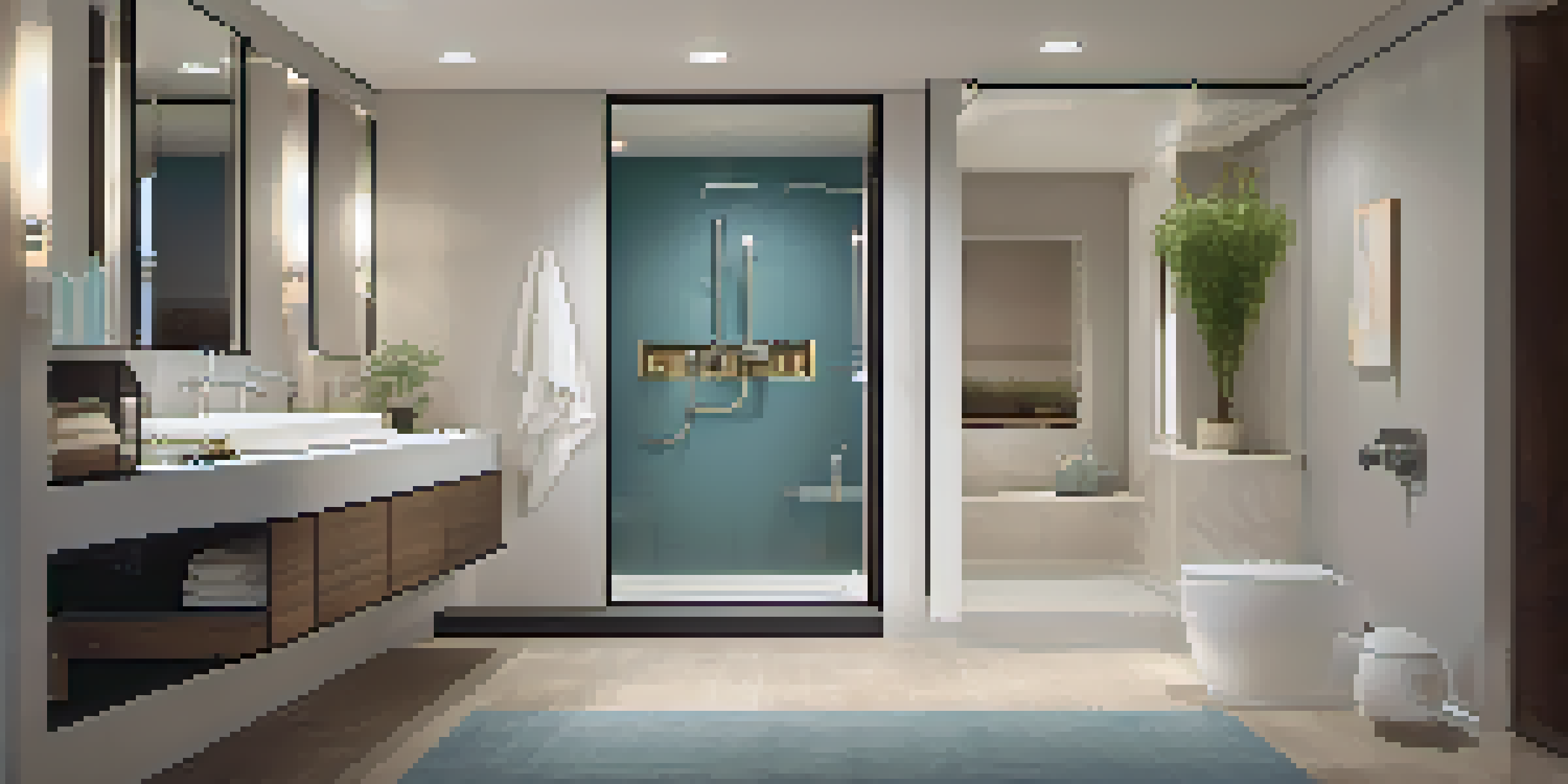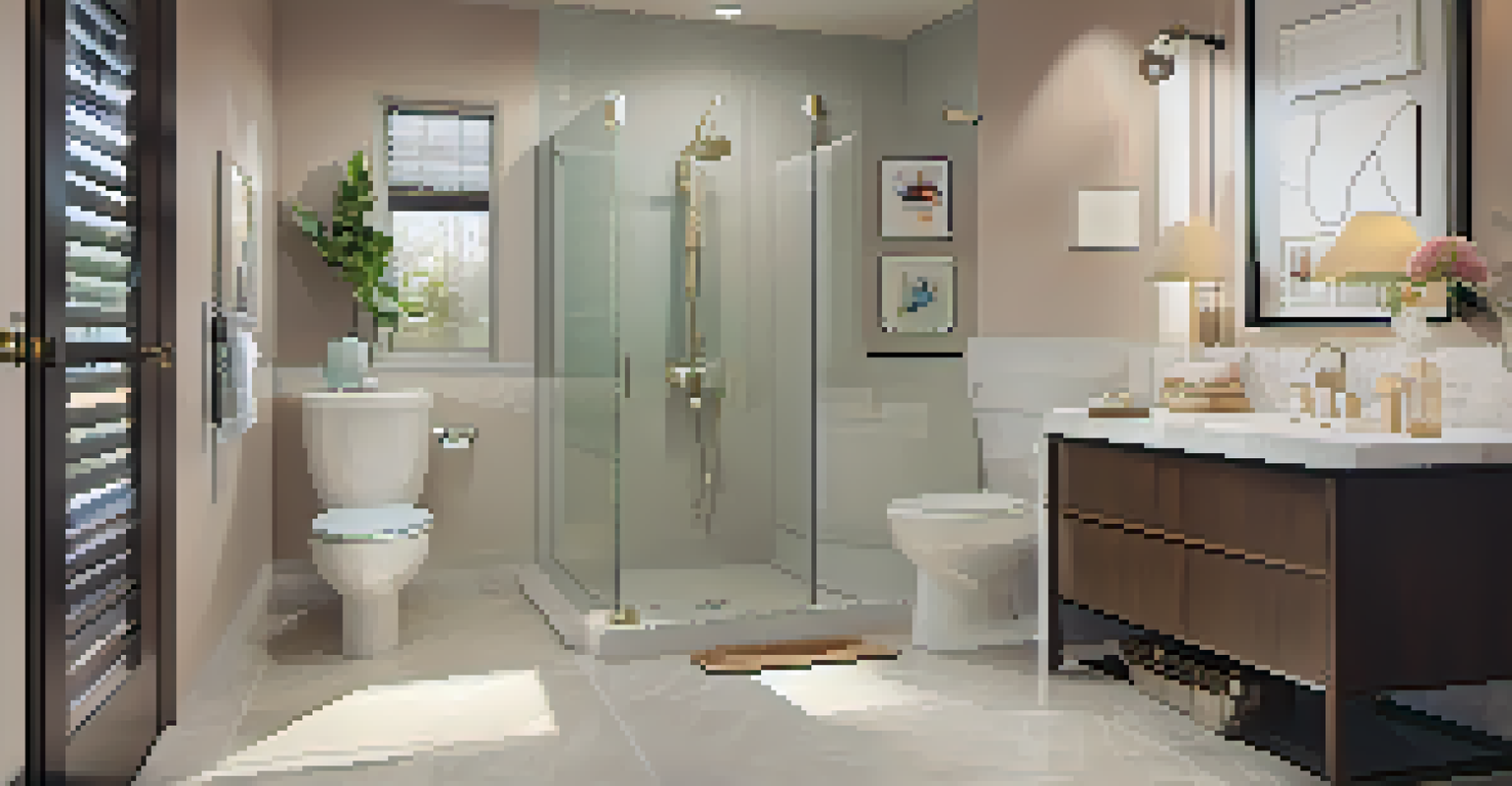Guide to Accessible Bathroom Fixtures for All Users

Understanding Accessibility in Bathroom Design
Accessibility in bathroom design is about creating spaces that everyone can use comfortably and safely. This includes considering the needs of individuals with disabilities, seniors, and even young children. The goal is to eliminate barriers and ensure that all users can maintain their independence and dignity in the bathroom environment.
Accessibility is not a privilege, it is a right.
When designing accessible bathrooms, it's important to focus on key elements such as space, height, and ease of use. For example, a wider doorway can accommodate wheelchairs, while fixtures at the right height can prevent strain for users of all ages. By understanding the different needs of users, we can create a more inclusive bathroom design.
Ultimately, accessible bathroom design benefits not just those with disabilities but also families and caregivers. For instance, a shower with a low threshold can help a parent easily bathe their child or assist an elderly relative. Emphasizing accessibility fosters a more accommodating environment for everyone.
Important Features of Accessible Toilets
Accessible toilets should be designed with specific features to enhance usability for all individuals. This often includes higher toilet seats, which make sitting down and standing up easier for those with mobility challenges. Additionally, grab bars next to the toilet can provide much-needed support for users who need a little extra help.

Another consideration is the placement of the toilet paper holder and other accessories. These should be within easy reach to avoid stretching or straining. The toilet should also have a flush mechanism that is easy to operate, such as a push button or lever, which can be more user-friendly than traditional handles.
Design for All Users
Creating accessible bathrooms ensures comfort and safety for everyone, including individuals with disabilities, seniors, and young children.
It's essential to remember that the design of accessible toilets can also improve comfort for everyone, not just those with disabilities. A well-designed toilet can make the experience more pleasant, demonstrating that accessibility is about enhancing the user experience for all.
Choosing Accessible Sinks and Vanities
Sinks and vanities play a crucial role in accessible bathroom design, and their height and depth are key factors to consider. An accessible sink should be mounted at a height that allows users in wheelchairs to comfortably roll underneath it. This allows for greater independence when washing hands or brushing teeth.
The future belongs to those who believe in the beauty of their dreams.
A wall-mounted or pedestal sink can offer more clearance for wheelchair users, while a spacious countertop can provide ample space for personal items. Additionally, lever-style faucets are ideal, as they require less strength to operate compared to traditional knobs. This small change can significantly improve ease of use for individuals with limited hand mobility.
Incorporating features such as adjustable mirrors can also enhance accessibility. A mirror that tilts or can be positioned at different heights ensures that everyone, regardless of their stature or mobility, can see themselves clearly. Thoughtful sink design promotes comfort and inclusivity in any bathroom.
The Importance of Accessible Showers and Bathtubs
When it comes to bathing, having accessible options is essential for safety and comfort. Roll-in showers with no thresholds allow wheelchair users to enter easily, while built-in seats provide a safe place to sit while showering. Handheld showerheads are also a great addition, allowing users to control the water flow without needing to stand.
For those who prefer baths, walk-in tubs are an excellent solution. These tubs have doors that allow users to enter without stepping over a high edge, significantly reducing the risk of slips and falls. Additionally, features like grab bars and non-slip surfaces are critical for ensuring safety in both showers and bathtubs.
Essential Bathroom Features
Key features like grab bars, adjustable sinks, and low-threshold showers enhance usability and safety for all bathroom users.
Ultimately, accessible bathing options not only support users with disabilities but also promote safety for older adults and children. By creating a bathroom environment that accommodates everyone, we enhance the overall experience of bathing.
Selecting User-Friendly Bathroom Accessories
Bathroom accessories play a vital role in creating an accessible environment. Items like grab bars, shower benches, and non-slip mats can significantly enhance safety and usability. Grab bars, for example, should be sturdy and strategically placed near the toilet and shower to provide support when needed.
Another important accessory is a shower bench, which allows users to sit while bathing, reducing the risk of slips. Non-slip mats can also help prevent falls, especially in wet areas. These accessories are not just for those with disabilities; they can benefit anyone who might need a little extra support while using the bathroom.
Selecting the right accessories can transform a standard bathroom into a safe haven. By prioritizing usability and safety, we can create spaces that are welcoming and accommodating for all.
Lighting Solutions for Accessible Bathrooms
Proper lighting is a key element in accessible bathroom design, as it helps ensure safety and visibility for all users. Bright, even lighting can prevent accidents by illuminating potential hazards, such as wet floors or obstacles. Consider using LED lights that provide bright, clear illumination while being energy-efficient.
In addition to overhead lighting, task lighting around mirrors and sinks can enhance visibility for grooming activities. Dimmable lights are also a great option, as they allow users to adjust the brightness according to their needs. This flexibility can be especially beneficial for individuals with visual impairments.
Future-Proofing Accessibility
Planning for future accessibility needs allows for easier adaptations as individual requirements change over time.
Creating a well-lit bathroom not only improves accessibility but also enhances the overall ambiance. Thoughtfully planned lighting can make the space feel more inviting and comfortable for everyone.
Incorporating Color and Design for Accessibility
Color and design elements can play a significant role in making bathrooms more accessible. High-contrast colors help individuals with visual impairments navigate the space more easily. For instance, using a darker color for grab bars against a lighter wall can make them more noticeable, encouraging safe use.
Additionally, selecting non-reflective materials can reduce glare, which is beneficial for individuals with vision challenges. Patterns should be avoided on flooring and walls, as they can create visual confusion. Instead, opt for solid colors that provide a calming and clear environment.

By considering color and design, we can create bathrooms that not only look aesthetically pleasing but also serve practical functions for accessibility. A well-thought-out design enhances usability while ensuring that the space remains stylish.
Planning for Future Accessibility Needs
When designing or renovating a bathroom, it's essential to think ahead regarding accessibility. As we age or face changing health conditions, our needs may evolve, and designing with these potential changes in mind can save time and money in the long run. For example, choosing adjustable fixtures can accommodate varying needs.
Incorporating elements like wider doorways, reinforced walls for grab bars, and accessible plumbing can make it easier to adapt the space as necessary. Planning for future accessibility ensures that the bathroom remains functional and welcoming for all users, regardless of their needs.
By being proactive about accessibility, we are setting the stage for a more inclusive environment. This foresight not only benefits individuals but also promotes a community ethos of care and consideration for all.